History Repeating – Robert Moore and the Dakota Territory
By Victoria MacGregor
I get goose bumps when I pass along parts of my family’s story to anyone who will listen. I must bore a few people to tears.
Much of what I like to write about involves a certain amount of creativity and loads of research. With any luck when I start to pull a story together, it’s a photograph that inspires my imagination.
Storytellers don’t need to have actually lived through an event or during a particular time themselves to be able to write about it with glorious details. All storytelling can’t be auto biographical. I’d hazard a guess that the bulk of stories come from bits and pieces passed down from our ancestors to us, either verbally or through diaries and journals. Then the author in us tosses in a little of this and some of that, a sprinkle of wouldn’t it be nice to know, to create a story worthy of a read by just about anyone, not just family.
Many writers would be out of work, and history would never get told if it weren’t for people wanting to write about the past.
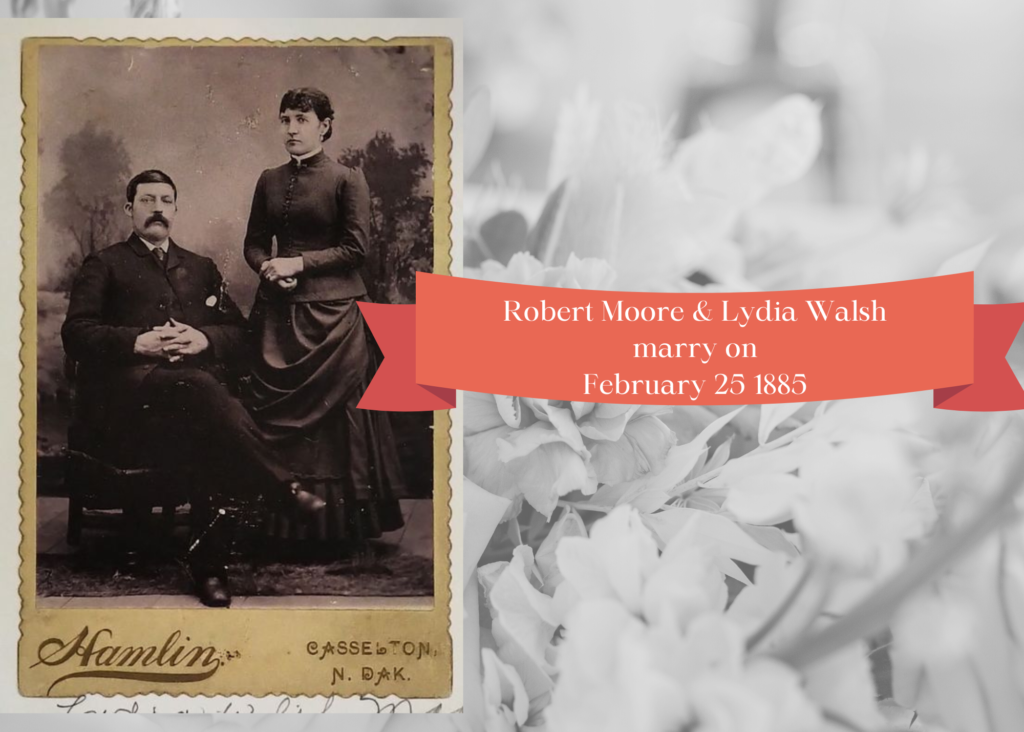
Wedding portrait Robert and Lydia Moore 1885.
A great grandfather’s story
My maternal great grandfather, Robert Moore, was born on 19 May 1850 in Bruce, Ontario, Canada. This largely forested area near the growing city of Toronto, was just being developed into farmland when Robert was born. His father, Walter was 28 and his mother, Mary Anne Shier was 24 at the time. They would have gone to Bruce County after migrating from Ireland to take up farming with their young and growing family.
I discussed briefly the tragedy that strikes the family when Robert was only 4 years old in a previous GSQ blog post, A Storyteller’s Voice Found in a Decades-Old Letter Adds to the Family Tree Story.
By 1885 Robert had found his way into the United States of America. He married Lydia Walsh in Casselton, North Dakota, on February 25, 1885, when he was 34 years old, and Lydia was 33. I do not know how or why Lydia left Toronto for North Dakota. Perhaps to find a husband? Was 33 considered old to be a bride?
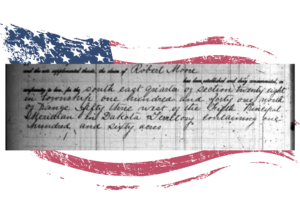
North Dakota Land description Robert Moore.
United States of America Homestead Act
In 1862 President Abraham Lincoln signed the Homestead Act. Between 1879 and 1886, more than 100,000 people settled in northern Dakota Territory. To claim 160 acres of free land, a man or a woman had to be head of a household and 21 years old at the time. The homesteader paid an $18US filing fee (just under $500.00 US today) and was allowed to live on the homestead for five years if they improved it.
Records indicate the Robert and some of his siblings became homesteaders. This document shows the tract of land that Robert was granted is signed on 15 December 1887 by the president of the day, Grover Cleveland.
Now it’s a farming family story
Fargo in the Dakota Territory would have been a harsh, unforgiving place through the winter months. Anytime of year daily life would have been hard. Sunlight hours are short in winter and the nights, bitterly cold. Add into the mix, drought, blizzards, and grasshopper plagues, making this a very unforgiving place. Their home possibly would have been a hand-built sod house.
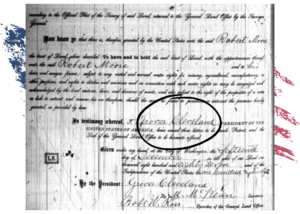
Land Grant signed by Grover Cleveland 1887.
The open Dakota territory was not known for its forests as Ontario had been. So lumber was at a premium, therefore mud and course prairie sod were all they had to make a shelter. Visualise how dark and damp these structures would have been?
This was the life they chose to go to. They, like so many other pioneers gambled that this pioneer life might bring them good fortune. They must have had a vision quite similar to that of their Irish migrant parents.
Robert and Lydia had three children in 6 years. Bertha in January 1886, Frank in September 1888, and Lydia May in February 1891. Imagine for a moment what starting a family would have been like while homesteading on 160 acres, without family living close by. It was their chosen life and must have seemed pointless at times. Two of their three children were born in the dead of winter. In the cold, damp, and isolated Dakota Territory. The inside of their sod hut would have been very basic, cramped and for a pregnant woman with two young children to entertain, in the middle of winter, near unbearable I would think.
Tragedy strikes, again.
Little Lydia May was born on February 5, 1891. Her mother Lydia, aged 39, died just 11 days after giving birth to her third child. One can only imagine what might have happened for things to go so horribly wrong. It was Lydia and Robert’s third child. What complications might have there been? No doctor or mid-wife. Perhaps there had been a terrible February storm that prevented help from getting out to the homestead? Those poor little children, Bertha and Frank. Too small to help their father with tiny Lydia May, but old enough to know that their mother would have suffered.
Clearly, something went extremely wrong, and my great grandfather, Robert, was now left alone with two children under 6 and a newborn in a sod hut in the middle of a North Dakota winter. For him it must have felt like history repeating itself. His own father dying tragically when he was just 4, and his mother was pregnant with her 5th child. In North Dakota as was February he wouldn’t have been able to bury his poor wife as the ground would have been frozen solid over 6 feet deep. It was the custom to leave the dead “on ice” until warmer spring weather arrived when the ground would have thawed out sufficiently to allow the grave diggers to do their work. How terrifying for the older children to have lost their mother. This family story, though, does have some happy times.
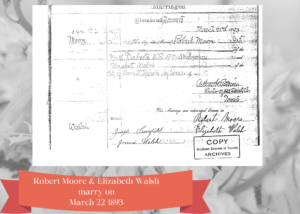
Marriage certificate Robert and Elizabeth Moore 1893.
Elizabeth Walsh (my great grandmother), Lydia’s younger sister, got the desperate message to go and help poor Robert with his children. Being an unmarried woman of 34, a spinster, there was nothing to keep her in Canada. She didn’t hesitate, and made the arduous journey, mostly likely by the newly opened train route to barren North Dakota. Two years later, Robert and Elizabeth married in Toronto Canada on March 22, 1893. They had two children together. Jennie was born May 5, 1894, in North Dakota, and my grandfather Clarence Moore was born August 21, 1896, in Canada.
The Dakota Territory chapter for this family story ends around 1895. I believe Robert was most likely in quite poor health and it was decided to return to Canada with his wife and still growing family. Robert died on June 7, 1902, in York, Ontario, Canada, at the age of 52, and was buried in Toronto. My grandfather was only 6 years old. History repeating, Elizabeth now the sole parent with 5 children to raise. By all accounts the five children considered Elizabeth their mother. Bertha, Frank and Lydia May would not have remembered their biological mother. Elizabeth’s niece and step-daughter, Lydia May, who was only 11 days old when her mother died, lived only to her 20th year, dying of meningitis in 1911.
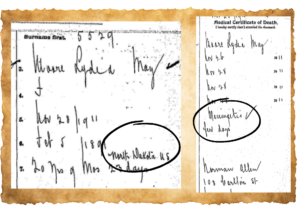
Death Certificate Lydia May Moore 1911.
I have always been fascinated by this family story. The strength of these people, the isolation the women must have endured and the incredible sacrifices they made for each other. It’s a family story that gets retold over and over again.
However, I want to know so much more, so my research is an evolving ongoing process.

I enjoyed your story. Thanks for sharing.
Thank you. It’s a fascinating part of our family story.